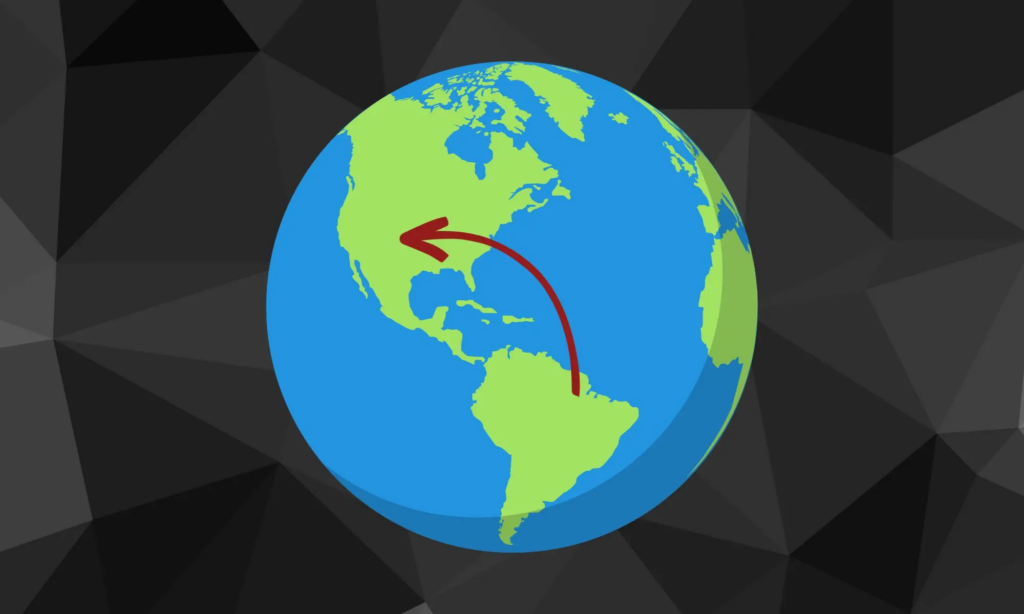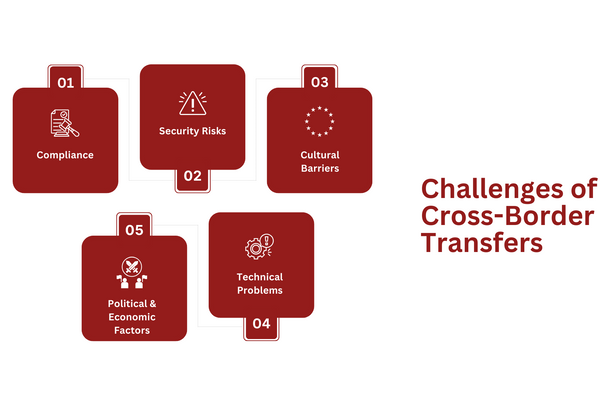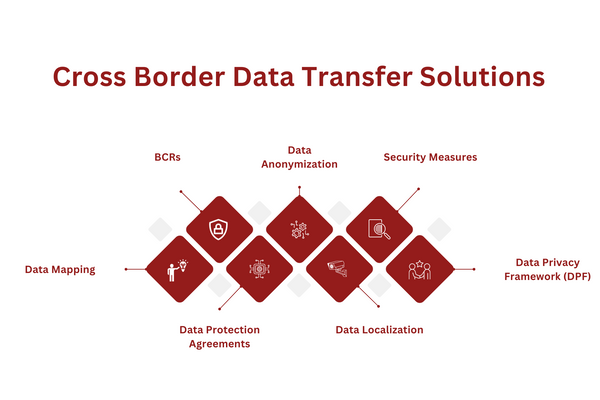Since President Donald J. Trump assumed office in January 2025, there have been notable developments in cross-border data transfer laws and regulations:
United States Initiatives:
- Department of Justice (DOJ) Final Rule: On December 27, 2024, the DOJ issued a Final Rule to implement Executive Order 14117, aiming to prevent foreign adversaries from accessing sensitive personal and government-related data. Effective April 8, 2025, this rule prohibits and restricts certain data transactions with countries of concern, including China, Cuba, Iran, North Korea, Russia, and Venezuela. U.S. entities must assess their data-sharing practices and implement compliance measures to adhere to these regulations.
European Union Developments:
- EU–US Data Privacy Framework: The European Commission adopted the EU–US Data Privacy Framework on July 10, 2023, to facilitate data transfers between the EU and the U.S. However, recent actions by President Trump, such as requesting the resignation of Democratic members of the Privacy and Civil Liberties Oversight Board (PCLOB) and reviewing prior national security decisions, have raised concerns about the framework’s stability. These developments could impact the legal basis for transatlantic data flows if the framework’s adequacy is challenged or invalidated.
These changes underscore the evolving landscape of cross-border data transfer regulations, necessitating continuous monitoring and compliance efforts by organizations engaged in international data exchanges.

Today, the world is more interconnected than ever before, and as a result, there are many cross-border data transfers that happen.
Information is constantly being shared across international borders. This free flow of data fuels economic growth, keeping businesses competitive.
However, along with these benefits come the unique challenges and complexities of cross-border data transfer. These involve protecting individual privacy rights, ensuring legal compliance in multiple jurisdictions, safeguarding national security interests, and maintaining necessary transparency.
We’ll cover all of this – including what cross-border data transfer is and how you can comply with it in this article.
Let’s dive right in.
Key Takeaways
Cross-border data transfer is the movement of data between two countries (i.e., Germany and Canada)
Challenges to international data transfers include compliance, security risks, cultural barriers, technology, and political & economic factors.
Solutions for data transfers across borders include data mapping, data localization, BCRs, DPAs, DPF, and security measures like encrypting data.
What is a Cross-Border Data Transfer?

Cross-border data transfer simply refers to the transmission of personal or other sensitive data from one country’s jurisdiction to another. For example, a business in the United States is transferring data to South Korea.
While today most data transfer happens over the Internet, this can also occur through other means such as private networks and physical media like USBs and hard disk drives.
For example, a company in the United States has a subsidiary in Germany and needs to transfer sensitive data to it. When it does so, this would be an international data transfer.
In this case, the company would first need to prepare the data and ensure all necessary safeguards are set in place before transferring the data – whether it be using encryption or other security protocols to ensure the data is protected during transfer.
Once this is done, the company can upload the encrypted sensitive data and transmit it securely over the Internet.
Upon receiving the data, the subsidiary company needs to decrypt it with the right key and then organize it.
How to Comply with Cross-Border Data Transfer Laws?
When transferring data across borders, both sides must follow the laws and regulations in their regions or countries.
The following section is an overview of how different data protection regulations handle cross-border data transfer and how you can comply with them:
GDPR Cross-Border Data Transfer Laws
Chapter 5, articles 44 to 50 of the General Data Protection Regulation regulates cross-border data transfers between EU and non-EU countries.
The EU does not impose any additional requirement for data transfer within its borders (for instance, between Germany and France). However, for non-EU data transfer, there are a few steps that your business needs to follow:
1. Getting an adequacy decision by the EU Commission
Namely, does the other country have an adequate level of data protection? You can find this information by going here and checking if the country you plan to transfer to has an adequate level of data protection.
2. Appropriate safeguards
If the other country is not covered by the Commission’s adequacy decision, other safeguards will be considered. These can be BCRs (from one company entity to another), contractual clauses, or additional safeguards.
However, in some cases, these steps won’t be necessary if:
Data subjects have given explicit consent
Data transfer is required for the completion of the contract
Public interest
Legal purposes
Vital interests of the data subject
Public register data
PIPL Cross-Border Data Transfer Laws
In China’s PIPL data protection law, there are a few steps to take to ensure your business is following its rules. These are outlined in Chapter 3 of the Law, “Rules for Cross-border Provision of Personal Information.”
First, if you’re sending someone’s data, you always need to get separate consent from them. This notice should include the foreign recipient, contact method, purpose of processing, and ways for people to exercise their rights.
Next, you also need to conduct a Personal Information Protection Impact Assessment or PIPIA (which is similar to a DPIA in that it evaluates risk) as outlined in Article 55.
A PIPIA is mandatory under PIPL for the cross-border transfer of personal data, processing sensitive personal information (SPI) when providing personal information to third parties, and for automated decision-making based on personal information.
You should also determine if the data is “important” or “personal.” For important data, you will need to complete a mandatory special security assessment.
On the other hand, for personal data, this assessment is only needed if you process the information of over 1 million people or export above 100k personal information or 10k sensitive personal information.
If your business does numbers under both of those amounts, an SCC or certification is all that will be needed.
LGPD Cross-Border Data Transfer Laws
Under Brazil’s LGPD, data transfer to another country or international organization is regulated by Chapter 5, Articles 33 to 36.
According to Article 33 of LGPD, international transfer of personal data is allowed only if it meets one of these requirements:
The other country or international organization provides data protection adequate to the LGPD.
The controller guarantees compliance via a contractual clause, global corporate standards, or a certificate, stamp, or code of conduct.
The transfer is necessary for legal purposes.
The transfer is necessary to protect the life/physical safety of the data holder or third party.
The national authority authorizes the transfer.
The transfer results in a commitment to an international agreement
The transfer is needed to execute a public policy.
In addition, the National Data Protection Authority (ANPD) needs to perform an assessment of the protection level of the country receiving the data, according to Article 34.
Challenges of Cross-Border Transfers

Cross-border data transfers have numerous other challenges besides ensuring compliance with the relevant data protection regulations and laws. To successfully manage the international transfer of personal and sensitive information, a business has to deal with these challenges:
Compliance
One of the biggest challenges companies face when transferring data is to stay compliant with the relevant data protection laws in their countries or regions.
This often means obtaining consent, performing a DPIA, and, in the case of some countries like China, meeting additional data localization requirements like passing a special security assessment.
Security Risks
Every time data gets transferred from point A to point B, it is exposed to a security risk from hackers, man-in-the-middle attacks, data breaches, or other forms of cyberattacks. This risk is only greater when data travels across the border.
Companies need to take extra precautions, such as using encryption and secure transmission methods, to safeguard the data during cross-border transfers. Additional security measures should be taken when transferring to higher-risk countries like Tajikistan, for example.
Cultural Barriers
Cultural barriers bring another challenge. For instance, the EU and most other countries view consumer consent differently than the US.
In the US, you don’t need to get consent (opt-in) from the consumer before processing their data. However, you have to give them the option to withdraw their consent (opt-out).
This difference can create confusion when transferring data from one region to another. Companies have to navigate these cultural differences carefully to ensure they are complying with all relevant laws.
Technical Problems
Different countries will often have different levels of IT infrastructure. For example, a report by SpeedTest puts Singapore as the country with the fastest WiFi (254.65Mbps) and United Arab Emirates fastest mobile Internet (210.89Mbps), while Cuba is at the bottom of both lists with 1.95Mbps WiFi speeds and 4.34Mbps mobile speeds.
Political & Economic Factors
Changes in government policies and regulations and tensions between countries can also impact international data transfer.
For example, if two countries are at war, like Russia and Ukraine, transferring sensitive data across their borders will be severely slowed down, if not completely stopped.
At the same time, economic factors, like trade restrictions or currency exchange rates, will also affect such transfers and increase their costs for businesses.
Cross Border Data Transfer Solutions

As you can see, navigating the complexities of cross-border data transfer can be challenging, so it’s necessary to implement different solutions, including:
Data Mapping
Data mapping serves two main purposes in personal data international transfer.
The first one is to help the business understand what data they have, where it is stored, and how it is processed by identifying and classifying it. Thanks to this, businesses can more effectively manage their data.
The second purpose is to aid in risk assessments and ensure only necessary data is transferred.
BCRs
When transferring data in a multinational organization across borders, it needs to abide by the relevant binding corporate rules (BCRs) in that organization.
The BCRs are there to provide a legal framework for data processing and handling in that company and need to follow the necessary data protection standards and best practices.
Data Protection Agreements
Data Protection Agreements, or DPAs, are legal documents signed between businesses and customers that settle how personal data is used, who has access to it, what can happen with the data, and data erasure.
Ultimately, DPAs help ensure that all parties protect data according to the legal and regulatory requirements.
Data Anonymization
To minimize data security risks when transferring PII across borders, data should be anonymized.
Anonymized data can then be used without the explicit consent of the other side for research and analytics purposes.
Data Localization
Some countries, like China, have strict regulations that require companies to store and process data within the country’s borders.
This means businesses may need to establish local storage facilities or find a third-party provider located in the desired country.
Security Measures
Security measures, like data encryption or using secure communication protocols like HTTPS or VPNs, are also vital to protect sensitive data crossing borders and reduce the risk of data breaches.
Data Privacy Framework (DPF)
The Data Privacy Framework (DPF) replaced the EU-US Privacy Shield in 2022 after it was declared invalid in 2020 by the EU Court of Justice. Now since Trump came into office there is a big shake up over this as we covered at the top of this guide.
The idea of the EU-US Privacy Shield was to be a legal framework for regulating personal data transfer for commercial purposes between the EU and the US. However, because of concerns about EU citizens’ data being subject to US surveillance, the DPF has been made.
Next Steps
Navigating the complexities of cross-border data transfers can be a challenge, considering all the regulatory, economic, and technological factors at play.
However, we hope we made this topic clearer through this guide and offered some solutions and best practices you can follow.
So, now that you have the information on hand, you must take action. That’s where Captain Compliance steps in. We can assist you through all your cross border data transfer and general compliance needs.
Get in touch with our data privacy and regulatory experts at Captain Compliance to help your business achieve compliance.
FAQs
What is cross-border data transfer under GDPR?
Cross-border data transfer under GDPR is the transfer of personal or other sensitive information between a GDPR country and a non-GDPR country.
How can data be transferred across international borders?
Data can be transferred using a physical medium like a hard disk drive, USB, or DVD or electronically, for example, via email or other communication protocol.
It is important to ensure that you follow relevant laws to ensure this transfer is done legally. This can mean appropriate safeguards or security assessments.
Learn more about appropriate safeguards you can take under GDPR.
What permits a cross-border data transfer outside the EU?
Cross-border data transfer outside the EU is regulated by Chapter 5 of the GDPR, “Transfers of personal data to third countries or international organizations.”
Can you transfer data outside the EU according to GDPR?
Yes, you can. This is regulated by Chapter 5 of the Regulation and can be based on:
The adequacy decision of the European Commission
Appropriate safeguards (including BCRs or contractual clauses)
Need help transferring data across borders? Reach out to us today so we can help.
What counts as an international data transfer?
Any transfer of data between the jurisdiction of one country and another is considered an “international data transfer.” For example, if a business transfers financial data between its HQ in the US and a subsidiary in Denmark, this is an international data transfer.
Learn more about data transfer requirements and why Captain Compliance is the fastest growing data privacy software company in the world right now.